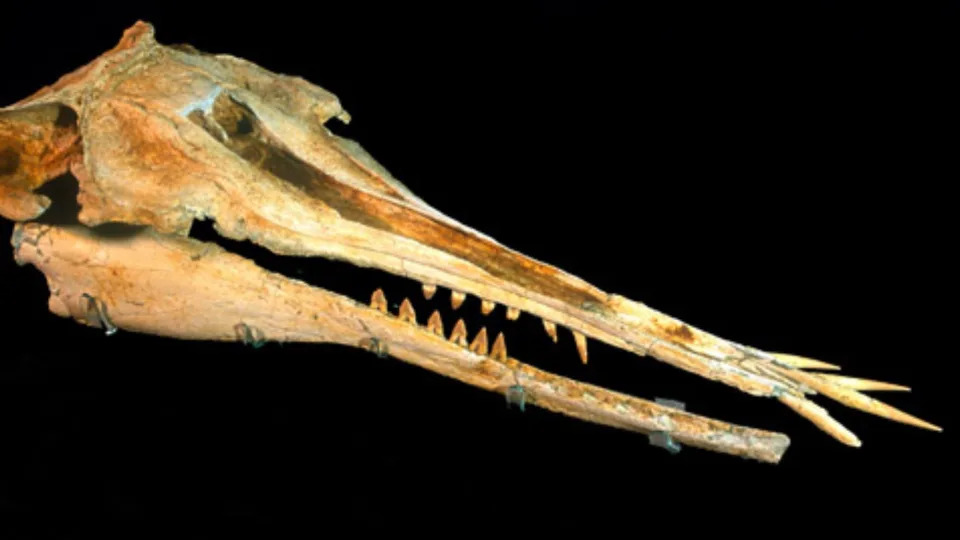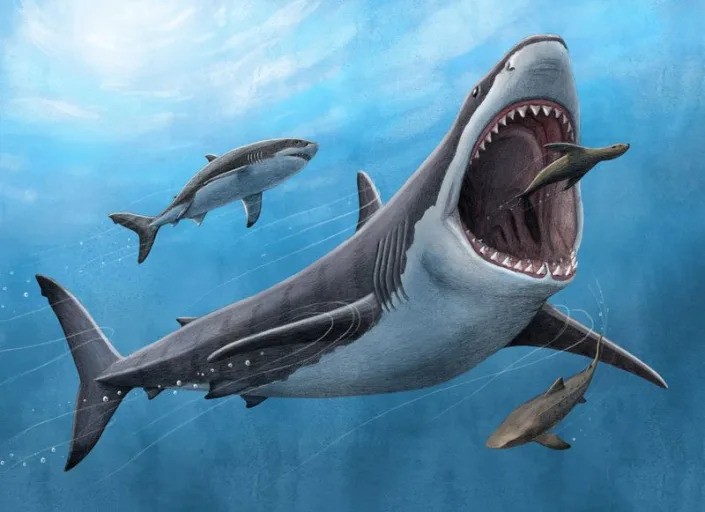Kristin Hugo
Updated Tue, June 27, 2023

The skull of the ancient dolphin Nihohae matakoi, which had jutting out teeth at the end of its snout, on a black background
The skull of the ancient dolphin Nihohae matakoi, which had jutting out teeth at the end of its snout, on a black background
A bizarre predatory dolphin that lived 25 million years ago and had long, sharp teeth jutting straight out from its snout has been discovered in a museum collection in New Zealand.
The toothy animal lived during the late Oligocene epoch (34 million to 23 million years ago). Scientists described the extinct dolphin from a near-complete skull found in a cliff face in New Zealand's South Island in 1998. They named the species Nihohae matakoi, from Maori words meaning "slashing teeth, face sharp."
Ambre Coste, a researcher at the University of Otago in New Zealand and lead author of a study on the dolphin, had noticed the strange skull in the collection and realized how well preserved and complete it was. "That's what made this skull so interesting," she told Live Science.
The skull, which is around 2 feet (60 centimeters) long, has regular, vertical teeth in the part of the jaw closer to the face, and flat, long teeth closer to the snout. These longer teeth, measuring between 3.1 and 4.3 inches (8 to 11 cm) seemed to jut out almost horizontally.
The flat teeth also don’t interlock, so the mouth is “nothing that would catch a fish,” said Coste.
Close examination of the teeth showed very little wear and tear, suggesting it is unlikely the animal was rooting around in the sand for food.
So what were these spade-like teeth for? To find out, the researchers considered the behavior of modern animals that have teeth jutting out from their faces: sawfish.

illustration showing a prehistoric dolphin with slashing, jutting out teeth chasing squid
Sawfish (Pristidae) are rays with snouts that look like long, flat chainsaws. According to a 2012 study in the journal Current Biology, juvenile sawfish "thrash" at food by hitting them with their teeth. "They just whack their heads back and forth," Coste said. "And that will injure or stun and kill that sort of prey, so then it’s easier to go and slurp it up."
The researchers believe N. matakoi may have done the same. This idea is supported by N. matakoi's cervical vertebrae, or neck bones, which were also part of the museum collection. Unlike many modern dolphins, these neck bones weren’t fused, meaning the animal had a bigger range of motion in its neck than many modern dolphins. This greater range of movement would likely have helped the dolphins to thrash their prey to death.
RELATED STORIES
—'Truly gigantic' Jurassic sea monster remains discovered by chance in museum
—Deadly cyclone unearths fossils of giant marine creatures that lived 80 million years ago
—Enormous 240 million-year-old sea monster had its head torn off in one clean bite
Because there wasn’t much wear on N. matakoi’s teeth, the scientists suspect the dolphins didn’t eat fish with hard bones or scales. Instead, the animals would likely have eaten soft-bodied animals like squids and octopuses.
It’s also possible the teeth had some sexual or social function, although this would be difficult to test, the study said.
The team said the use of these strange jutting teeth should be investigated further to understand why they evolved — and why teeth like this keep appearing in different groups of animals.
The study was published June 14 in the Proceedings of the Royal Society B.
Tooth analysis confirms the megalodon - a huge ancient shark - was warm-blooded

An illustration shows the large extinct shark megalodon, Otodus megalodon, preying on a seal
Tue, June 27, 2023
By Will Dunham
WASHINGTON (Reuters) - The megalodon, a huge shark that was the scourge of the ancient oceans and is a star in modern movie theaters, is named for its "large tooth" - and for good reason. Its serrated teeth - up to about 7 inches long (18 cm) - could tear through any prey in the deep blue sea.
Those teeth now are providing a fuller understanding of this extinct predator, with an analysis of the mineral makeup of their enamel-like tissue confirming that megalodon was warm-blooded - a trait scientists suspect contributed both to its tremendous success and eventual downfall.
Researchers estimated that megalodon, which reached at least 50 feet (15 meters) and possibly 65 feet (20 meters) long while hunting marine mammals including whales, boasted an overall average body temperature of about 81 degrees Fahrenheit (27 degrees Celsius) and could keep it at about 13 degrees F (7 degrees C) above that of the surrounding seawater.
This may have made megalodon a more dynamic predator - a strong swimmer able to digest food in an energetically efficient manner and, importantly, tolerate colder water, letting it broaden its range to nearly worldwide.
Most fish are cold-blooded - ectothermic - with body temperatures matching the surrounding water. But a few are warm-blooded - endothermic - generating their own body heat. Examples include certain sharks including the largest modern one, the great white.
"The only comparable living species today in terms of both diet and body temperature are the great white shark and, to a lesser extent, the mako shark. Though, as shown in our study, megalodon was quite a bit warmer than both of these modern apex predators, which makes megalodon unique," said geochemist and paleoclimatologist Michael Griffiths of William Paterson University in New Jersey, lead author of the research published in the journal Proceedings of the National Academy of Sciences.
The study found that megalodon, while warm-blooded, had a lower body temperature than whales.
"One theory is that they were regionally endothermic - that some parts of their body were warmer than other parts, whereas body temperature is higher and more uniform across the body in most large mammals," UCLA atmospheric and oceanic scientist and study co-author Robert Eagle said.
Megalodon, perhaps the largest shark of all time, appeared about 23 million years ago, then disappeared about 3.6 million years ago amid declining ocean temperatures and sea levels.
Warm-bloodedness could have been useful for megalodon in cooling waters.
"Yet, the fact that the species became extinct suggests the probable vulnerability - or the cost - of being warm-blooded because warm-bloodedness requires constant high food intake to sustain high metabolism," paleobiologist and study co-author Kenshu Shimada of DePaul University in Chicago said.
"It is quite possible that there was a shift in the marine ecosystem due to the climatic cooling that caused the sea level to drop, altering the habitats with the populations of the types of food megalodon depended on, such as marine mammals, possibly becoming scarce, leading to the extinction of megalodon," Shimada added.
Scientists previously had suspected megalodon's warm-bloodedness but the study provided the first empirical evidence. The researchers analyzed geochemical characteristics in fossil megalodon teeth to determine the temperature at which minerals in enamel-like tissue formed - an indicator of body temperature.
After being overshadowed for decades in popular culture by the great white - think the 1975 blockbuster "Jaws" and its endless progeny - megalodon is now in the spotlight thanks to the 2018 film "The Meg" and its upcoming sequel "Meg 2: The Trench."
"Megalodon is primarily represented only by teeth and a handful of vertebral specimens in the fossil record," Shimada said. "Contrary to novels and movies that portray megalodon as a super-sized, monstrous shark, the fact is that we still don't even know exactly how it looked or how it lived. This is exactly why the 'science of Megalodon' continues to be an exciting academic field."
(Reporting by Will Dunham, Editing by Rosalba O'Brien)
No comments:
Post a Comment